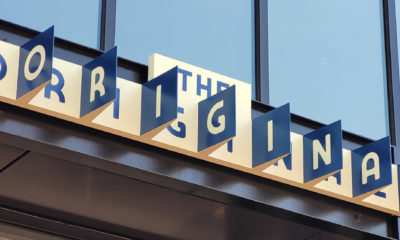Cornwall, Ontario, is large enough to provide the amenities of a buzzing metropolis, yet small enough to have that home-town flavor. Outdoor enthusiasts enjoy hockey rinks, softball fields, great fishing and a bike path. For those of us longing for a taste of culture, we have an incredible public library, museums, theatres and a public art gallery.
The gallery’s new sign is the topic of this article. Located on the city’s main street, the Cornwall Regional Art Gallery showcases both local and regional artists, as well as national exhibits. Life drawing and sculpture classes are offered weekly. Also, local high-school artists present their work in an annual exhibition. When the gallery’s building recently underwent a facelift, the old sign was removed, and plans for a new one began.
Oddly enough, the former sign was a creation of ours from many years ago, when we first began experimenting with dimensional signs (and we were still flexing our design muscles). Letters were cut with a jigsaw from 3/4-in. MDO, sealed and painted. We also experimented with the contrast between a flat and glossy finish on a flat, painted surface.
It looked great until the first rainfall and the flat finish dried streaky. Ah, the lessons we learn. How many jobs have we all finished and said, "If I ever have the chance to do it over again, I would…" This was our chance. Adding new dimensions We knew from the beginning that we would create something dimensional, we just didn’t know to what extent until the budget was approved.
We always prepare proposals based on three levels of complexity in the hopes that at least one scenario will suit the client. In this case, we landed in the middle, which happens 80% of the time. Having a reference library is perhaps one of the most valuable investments in our shop.
Our main references for this sign design project were Designage: The Art of the Decorative Sign, by Arnold Schwartzman (available from ST Publications, $18.95); Treasury of Art Nouveau Alphabets, edited by Ludwig Petzendorfer; The Art of the Cigar Label by Joe Davidson, and Classic Clip Art, published by Gloria Hale Books. Each of these books offered ideas on texture, shape, color and balance. We aimed for a design style somewhere between Art Nouveau and funky.
Advertisement
The building’s plain facade — gray brick with a narrow burgundy band running above the window line — presented a great backdrop for our design. We chose rust, olive green and yellow for our palette because they have worked well for us in the past, and they work well with the pre-existing burgundy. $image2
Project details
The materials of choice for this job were PVC and HDU. We cut all the components on |1137|’s (Manchester, CT) Sabre 408 router. The letters were programmed with guidelines for the pattern in the strokes, and then were carved and shaped by hand. Gerber Scientific Products
The rust background was engineered in two sections (stock material length is 8 ft., and this sign measures 14 ft.) to make assembly and installation more practical. The rust and black outlines are made out of 3/4-in. and 1/8-in. PVC, sprayed with Krylon® and finished with Sico (Etobicoke, Ontario) acrylic latex paint.
We routed the scrolls with the auto-carve feature on the 408, and then inlayed in 3/4-in. PVC. The "Art Gallery" letters were primed with Jay Cooke primer, topcoated with Chromatic background enamel, and the fade was sprayed on with Krylon. The layers were then laminated with Formuflex glue and fasteners.
The pictorial presented a challenge because the gallery exhibits so many styles of art. The gallery director and we agreed that the sign should present a scene familiar to both artists and the public. The painter’s palette and model became the subject matter, along with Noëlla’s impressionistic interpretation.
Advertisement


 Photo Gallery1 week ago
Photo Gallery1 week ago
 Ask Signs of the Times1 week ago
Ask Signs of the Times1 week ago
 Paula Fargo5 days ago
Paula Fargo5 days ago
 Real Deal2 days ago
Real Deal2 days ago
 Benchmarks2 weeks ago
Benchmarks2 weeks ago
 Photo Gallery5 days ago
Photo Gallery5 days ago
 Women in Signs1 week ago
Women in Signs1 week ago
 Women in Signs1 week ago
Women in Signs1 week ago

















